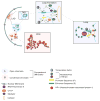Spatial genome organization and cognition
- PMID: 27708356
- PMCID: PMC5503467
- DOI: 10.1038/nrn.2016.124
Spatial genome organization and cognition
Abstract
Nonrandom chromosomal conformations, including promoter-enhancer loopings that bypass kilobases or megabases of linear genome, provide a crucial layer of transcriptional regulation and move vast amounts of non-coding sequence into the physical proximity of genes that are important for neurodevelopment, cognition and behaviour. Activity-regulated changes in the neuronal '3D genome' could govern transcriptional mechanisms associated with learning and plasticity, and loop-bound intergenic and intronic non-coding sequences have been implicated in psychiatric and adult-onset neurodegenerative disease. Recent studies have begun to clarify the roles of spatial genome organization in normal and abnormal cognition.
Conflict of interest statement
Competing Interests Statement: There is NO Competing Interest.
Figures



References
Publication types
MeSH terms
Substances
Grants and funding
LinkOut - more resources
Full Text Sources
Other Literature Sources

